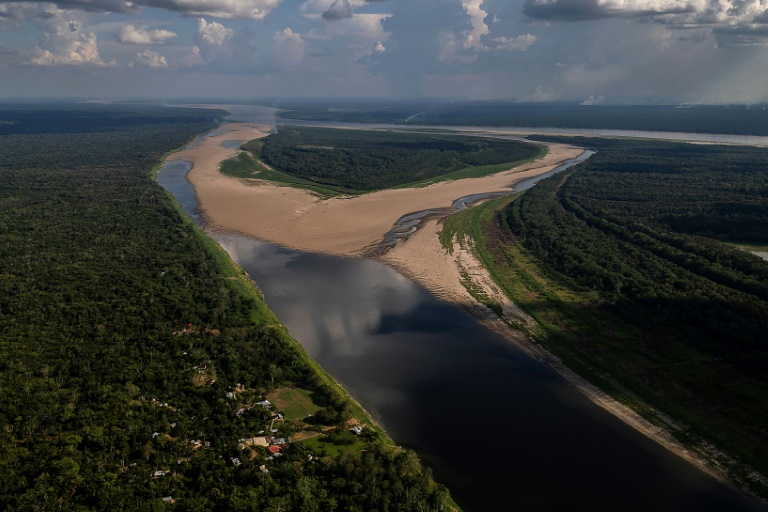Carrying six-liter bottles of water on their shoulders, members of Colombia’s indigenous Yagua community walk along the dried-up riverbed of a tributary of the mighty Amazon.
In the Three Frontiers region, where Colombia borders Brazil and Peru, the flow in some parts of the world’s largest river has shrunk by 90 percent by volume, leaving a desert of brown sand full of ripples.
Near the Colombian border town of Leticia, the 600 residents of a Yagua village gaze out over a mile-wide pop-up beach.
Before the smaller of the two branches of the Amazon that flow past Leticia began to dry up three months ago, it took villagers only about 15 minutes to reach the river’s banks.
Now they have to walk for two hours under the scorching sun to reach the dock for boats that bring food, fuel and drinking water on the only route in and out of the jungle.
“This is a very difficult time,” Victor Facelino, a 52-year-old Yagua man, told AFP as he dragged home a water bottle donated by the state to quench the thirst of people living in the world’s largest rainforest live.
“Sometimes we get stuck in the sand,” he said, panting.
Colombia’s National Disaster Risk Management Unit (UNGRD) blames the Amazon’s worst drought in nearly two decades for the river’s dramatic shrinkage in the Three Frontiers region.
“For many of these communities, the river is the only means of transportation, and the drying up of tributaries has completely cut them off,” said Carlos Carrillo, director of the UNGRD.
– ‘Just like before’ –
The governor of Colombia’s Amazonas department, a 109,000-square-kilometer swath of forest, said the drought was the “worst climate crisis” ever seen in the area.
According to Europe’s Copernicus Climate Observatory, it coincides with the worst forest fire season in the Amazon in almost two decades.
On the Peruvian side of the border, several cities have reported food shortages.
On the Brazilian side, choking under fumes from fires, authorities have declared a “critical situation”, with low water levels at a hydroelectric plant that generates 11 percent of the country’s electricity causing particular concern.
The logistics problems have caused the price of basic goods, including fuel, to skyrocket. Fishermen are forced to travel further and further upstream to cast their nets.
“If you look along the river, it is dry everywhere,” complained Roel Pacaya, a 50-year-old fisherman from the town of Puerto Narino.
Maria Soria, a Yagua woman who makes a living selling handicrafts on Monkey Island, a nature reserve in the Colombian Amazon, fears that soon “the whole river will dry up.”
“I ask God to change it back to how it was so that we can live as before,” said the 55-year-old, wearing a traditional headdress with blue feathers and a chest covering made of palm fibers to perform a dance for a small group of tourists.
– Going with the flow –
Even for those who still have access to the river, it’s not easy.
Eudocia Moran, 59, says she feels trapped by the now stagnant waters of the Amazon, which are just meters from her home.
Shopping trips to Leticia, some 50 kilometers downstream, have become rarer, with boat operators fearful of being stranded in the sand.
Moran, a leader of Ticuna’s indigenous community, is convinced the solution is a return to the land.
Instead of relying on an increasingly slow trickle of tourists, she believes the only way to survive is to “fully immerse ourselves in agriculture.”
In a garden irrigated by a stretch of river, she grows cassava, beans, corn and fruit.
“I tell everyone that we have to go with the flow of the times because all we can do is learn to live.”
das/lv/cb/nro







